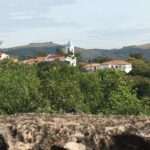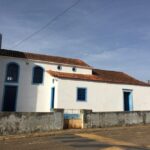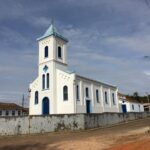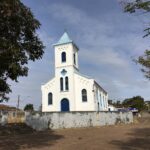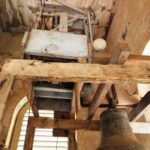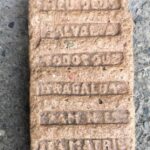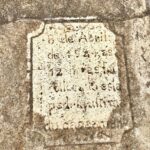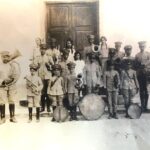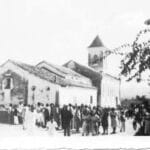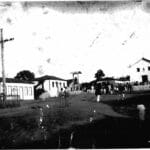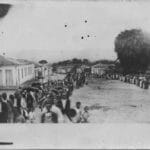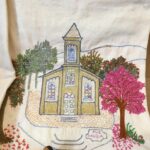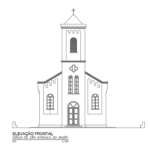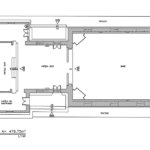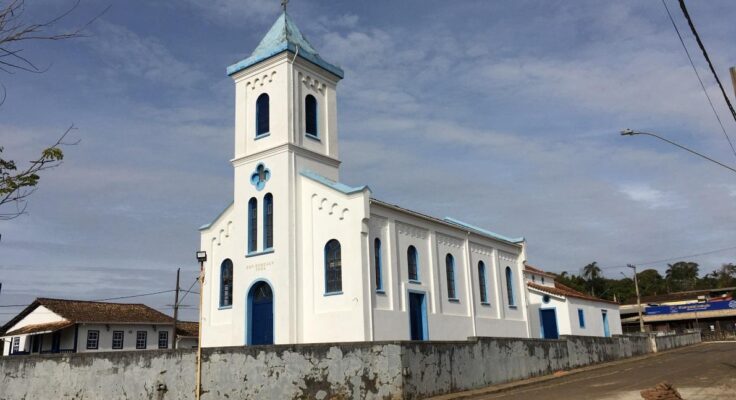
Church of São Gonçalo do Bação
HISTORY OF THE CHURCH OF SÃO GONÇALO DE AMARANTE
SÃO GONÇALO DO BAÇÃO DISTRICT OF ITABIRITO – MINAS GERAIS
Prepared by Mauro Antônio de Souza (Theatrical Director and writer)
The São Gonçalo de Amarante’s Mother Church, located in the town of São Gonçalo do Bação, in the municipality of Itabirito-MG, is the postcard of the district. The Church is located inside a paved and stone-walled forecourt, in the center of the town. It consists of three rectangular volumes with a single central tower, a chancel flanked by wide aisles and accesses with full arches where the Chapel of the Blessed Sacrament and the sacristy are located.
The Church is composed of three interspersed typologies that highlight the three construction stages: 1740 (the first chapel, where the sacristy is today); 1870 (when there was an expansion of the initial chapel); 1924 (conclusive in neo-romantic style, consisting of a central tower).
In this tower there are still traces of a wooden clock, the work of Mr. José Victor Gomes, who was a potter, builder, artist and inventor, and who also built the access stairs to the second floor, in addition to the side sinks.
These interventions also added different architectural styles: neo-Gothic, in 1870, and neo-romantic, in 1924, giving important testimony to the evolution of architecture in the country. The main altar retable, expressive Baroque carvings from the initial chapel, was taken to the church sacristy.
The dates of the three stages of construction are engraved on the stone of the main door staircase: 1740, 1870 and the date of the third construction, 1921 to 1924. (IFT, 2017)
The first chapel (l740) was built by Antônio Alves Bação, a Portuguese man who prospected for alluvial gold in the surrounding rivers. The name Bação originated from the surname of this Portuguese man. Some say it’s Vação, Vaçon, others say Basson. No one knows for sure. It is said that this Portuguese man, prospecting the surroundings of the village that today we call Córrego do Bação, fell ill and made a promise to the Portuguese saint São Gonçalo de Amarante: getting better from his illness, he would build a chapel for the saint. Upon recovering his health, oral tradition tells that he brought an image of São Gonçalo from Portugal, placed it on a donkey and built the chapel where the animal stopped.
This narrative does not go back to any written document, demonstrating the affective relationship of residents with the district and the importance of the church for the local culture. The strength of this local memory is the subject of research, having been transformed into a theatrical play, “A Saga Baçônica”, presented for the first time in 1998 by the São Gonçalo do Bação Theater Group and in 2014 printed in a book.
Around the church, there are alleys with stone walls and several properties remaining from the 18th and 19th centuries, making up an architectural complex of tourist attraction in which the Mother Church of São Gonçalo is the central element.
Currently, as of April 2021, through the effort and monetary contribution of the community and friends of São Gonçalo do Bação, the church of São Gonçalo underwent an intervention to clean the gutters, including those of the tower, removal of small bushes from the tower, external painting with new colors, reinforcement in the windows that were damaged. It also needs the restoration of the artistic, architectural and structural elements of the church.
From the Parish Memorandum of the Parish of São Gonçalo do Bação, we extract some quotes:
- In colonial times, when the Portuguese mined for gold on the beaches of this locality, they built a chapel of stone, having as Orago São Gonçalo de Amarante and finishing it in 1740, and the small population of those times was named São Gonçalo do Bação .
- This chapel was a branch of the Parish of Itabira do Campo until January 10, 1883, when this parish was canonically created, being Bishop of Mariana the Hon. Rev. Mr. D. Antônio Maria Corrêa de Sá e Benevides, being its Vicar General Monsignor Silvério Gomes Pimenta.
- We make it known that since the District of São Gonçalo do Bação, from the term of Ouro Preto, has been elevated to the Parish Category, by Provincial Law of October 23, 1882, under nº 2898, dismembered from the Parish of Nossa Senhora da Boa Viagem de Itabira of the Field of this Bishopric.
- On January 28, 1883, Father Antônio Cândido Torres de Santana took possession of the new parish. (IFT, 2017)
Architectural description
The church presents an atypical architectural design, being built in several stages in the 18th, 19th and 20th centuries.
Facing northwest, it is located in the central area of the urban fabric, in the center of the churchyard delimited by a low wall, with access through a front and two side gates. It has a central tower finished off by a prismatic mortared roof and specific roofs for the body of the nave, chancel and sacristy in gables, with curved ceramic tiles. The main access is via the vestibule or atrium, flanked by the baptistery and the stairs leading to the choir, which is where you reach the floor of the single tower. The nave houses two side altars, possibly from an earlier stage, in Rococo style, which differs from the architecture of the body of the nave in Neo-Romanesque style. Beside each of the side doors of the nave and main chapel, there are holy water fonts, semi-embedded in the masonry. Between the nave and the chancel, there is a space that houses the benches of the chancel itself. This is inserted within the original construction, remaining from the first chapel built. After the first reform that created the space for the benches mentioned above, an area was added on the right side that houses the chapel of the Blessed Sacrament. On the left side, a corridor was created that gives access to the sacristy, inserted inside the body of the first chapel. The ceilings of the chancel (with decorative painting) and nave are in faceted vault; The nave’s floor is made of narrow boards and the other floors covered with hydraulic tiles of different patterns. All walls receive stamped paintings.
The main altar is in neo-Gothic style with a varnished finish. The main altar’s niche has an ogival arch at the end of the span. Between the floor and the corridors that flank it, the large spans are in full arch, with cast iron balustrades. The sacristy preserves an inscription on the wall informing the first reform and an altar – possibly one of the oldest in the church’s primary collection. The doors are in wood. The frames of the primitive body have straight lintels. The windows of the additions have full arched lintels, sealed with iron frames and colored glass composing simple stained glass straight windows. It has an approximate projected area of 477m².
Narrativa
“Father Antônio Cândido was a very good parish priest. He encouraged the band and musicality in São Gonçalo do Bação.”
Testimony from Mrs. Divina, 94 years old, resident of São Gonçalo do Bação. She also commented that at the back of the church there was once a cemetery. Years ago, a cleaning was necessary inside the church (in the oldest part), because the floor was swelling, due to wood and bones that were underneath.
Assessment of the state of conservation/date/suggestions
The building needs careful intervention. It presents structural problems, the applied art elements need urgent intervention and the wooden structures, such as floors and ceilings deteriorated by the action of xylophagous insects and others.
Registration in other heritage and environmental bodies
It is included in the list of Inventoried Goods of the Municipality of Itabirito (Code EAU.07.14)
Notes
-This set of inventories was prepared exclusively for the purpose of registering the cultural assets indicated by the community of São Gonçalo do Bação to meet the signaling, digital registration and enhancement program for Alleys, Fountains and Historic Attractions Circuits; - The contents of these inventories, if used in reports, other types of inventories and/or publications, must be duly cited, following ABNT rules; - The authorship of the photos and the origin of the iconographic collection (either personal or family collection) must be mentioned.
Bibliography
| INSTITUTO FEDERAL DE MINAS GERAIS CAMPUS OURO PRETO - CURSO SUPERIOR DE TECNOLOGIA EM CONSERVAÇÃO E RESTAURO; DANIELLY NARDUCCI GUALANDE, JULIANO RIBEIRO DE ÁVILA TORRE, SABRINA DELAMORE DE SOUZA, MARIA GORETTE SANTOS PASSOS COUTO. IGREJA MATRIZ DE SÃO GONÇALO DO BAÇÃO - DISTRITO DE ITABIRITO – MINAS GERAIS. Ouro Preto 2017. |
|---|
Information sponsors
Alenice Baeta, Cristina Cairo, Hudson Faria e Pedro Loredo

